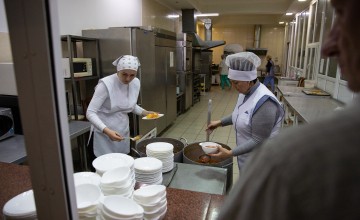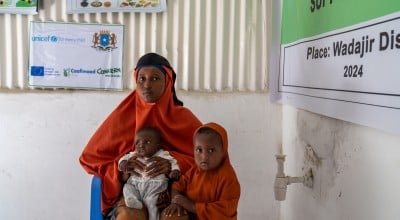
Read our 2024 annual report

Knowledge Hub
Learn about how a conflict in eastern Europe is affecting hunger around the world.
Within the first weeks of the invasion of Ukraine, those of us in Ireland could feel some immediate knock-on effects: rising energy bills, petrol prices, and overall inflation rates.
As Concern soon learned in its immediate response to Ukraine’s humanitarian crisis, many of these issues were amplified within Ukraine itself. Essential services and infrastructure were halted, if not completely destroyed. Supermarket shelves were bare, hospitals were levelled by missiles, and — with 2 million Ukrainians fleeing their homes within the first two weeks alone — needs for basic items like food and water were skyrocketing.
With no end to the conflict in sight, millions of Ukrainians have settled into an uneasy sense of normalcy. Many have returned to their homes, or travel back and forth between temporary homes and their families and businesses closer to the frontlines. As Concern Surge Team member Charlie Acland put it in February of this year, despite ongoing inflation costs contracting the economy by roughly one-third, “supply chains are still running, markets and shops are still open; the physical access to goods is there.” The situation remains tough for many; tougher, even, than it was in the conflict’s first uncertain months.
However, the crisis of inflation and supply shortage as a result of the crisis in Ukraine doesn’t stop in eastern Europe. In fact, a food crisis linked to the conflict has been having an even starker impact on people 5,000 kilometres away. Here’s what you need to know.
The ripple effects of a conflict in eastern Europe
First things first, when we talk about a Ukraine food crisis, we’re talking about the global impacts of a conflict focused in eastern Europe. Even halfway across the world, one-fifth of humanity have been affected by the conflict in Ukraine on one (or more) of three levels:
- Rising food prices
- Rising energy prices
- Tightening financial conditions
An estimated 1.7 billion people are severely exposed to at least one of these effects. That’s 20% of the global population. Even more disconcerting: Of that 1.7 billion, 70% are particularly vulnerable to all three effects, and are therefore poised to suffer them the most.


When one of the world’s largest breadbaskets is overtaken by conflict
Together, Ukraine and Russia form one of the world’s largest “breadbaskets,” producing 30% of global wheat and barley supplies. This includes 36 countries that import more than 50% of their wheat from Ukraine and Russia, including Burundi, the Democratic Republic of Congo, Lebanon, Pakistan, Rwanda, Somalia, Sudan, and Türkiye. Some countries, like Sudan and Somalia, import nearly 90% of their wheat from this region.
In addition to its wheat and barley supplies, the region provides 20% of the world’s maize, and over half of the world’s sunflower oil. Russia is also the world’s top natural gas exporter and second-largest oil exporter, and, alongside neighbouring Belarus, exports a fifth of the world’s fertilisers.

A devastating — and ill-timed — holding pattern
At the onset of conflict in 2022, exports were immediately halted from both Ukraine and Russia. The timing of this could not have been worse in countries like Somalia, which were facing famine-like conditions due to the drought crisis in the Horn of Africa. There, wheat prices doubled nearly immediately.
The Black Sea Grain Initiative, led by the UN and Türkiye (which governs the maritime routes most often used by Ukraine and Russia), helped to alleviate this and re-open trade lines. In one year, 33 million tonnes of grain and other food exports were delivered to 45 countries. Renewed several times since then, the contract expired in July of 2023, after Russian delegates refused to sign a new extension.

Available doesn’t mean affordable
The largest impact of this contract lapsing is being felt in countries like Somalia. According to Reuters, grain prices dropped by 25% when the initial Black Sea Initiative was signed. Now, prices have risen again, with some traders in Mogadishu estimating a 50% increase in the price on a 50kg bag of wheat. The Integrated Food Security Phase Classification (IPC) estimates that 4.3 million Somalis are expected to face crisis-levels of hunger or worse, including 1 million people who will be facing emergency levels of hunger; the last step of food insecurity before a famine or famine-like conditions.
As the Food and Agriculture Organisation (FAO) noted in its April 2022 food price index, food rates had gone up by 34% compared to the previous year, an effect largely predicated upon the conflict in Ukraine. While its July 2023 index shows a steady decrease in prices since then, it did note that the lapse of the Black Sea Initiative caused the price of vegetable oils to rise by 12%. Grain prices also increased modestly due to the contract’s expiration, though that increase was offset by large harvests in Argentina, Brazil, and the United States.

How fuel shortages affect hunger
This issue goes beyond wheat and the Horn of Africa. Within the first few weeks of the crisis in Ukraine, a 50kg bag of rice in Sierra Leone went up by 20%. At the same time, Sierra Leone’s Petroleum Regulatory Agency (PRA) increased the ceiling prices for petrol and diesel by 34% and 40%, respectively, compared to January of 2022. They concretely cited the cause of this inflation as the “deteriorating geopolitical situation in Europe.”
The increase in fuel prices has also contributed to the hunger crisis. The FAO has also pointed to the increase in crude oil and gas prices to a decrease in food supply transportation.
The crisis in Ukraine isn’t the whole story
This situation would be difficult in any circumstances, but rising food prices are coming after a series of challenges that have already increased the overall cost of living, reduced income, and exacerbated instability.
Since 2019, the number of people experiencing hunger has increased by 122 million around the world — approximately 20% of the global population. COVID-19-related border closures and lockdowns had a large knock-on effect that led to world hunger levels increasing. The effects of the climate crisis have affected regions like the Horn of Africa, decimating the livelihoods of farmers and pastoralists who don’t have the resources to recover or adapt.
The result is what UN Secretary-General António Guterres describes as “a perfect storm” that “shows that there is a direct correlation between rising food prices and social and political instability. Our world cannot afford this. We need to act now.”

The Ukraine food crisis: Concern’s response
Shortly after the invasion of Ukraine, Concern began responding to the fast-growing crisis, first in neighbouring countries taking in refugees, and, several weeks later, in Ukraine itself. In the country’s eastern regions, we work as part of the Joint Emergency Response in Ukraine (JERU) with local partners to provide cash transfers, food- and non-food supplies, and psychosocial support to thousands of families displaced by violence.

Concern has also been working in many of the countries hit hardest by the Ukraine food crisis, in some cases for decades. Our teams in the Horn of Africa (Ethiopia, Kenya, and Somalia) reached 1.5 million people last year alone with a range of services addressing the rising numbers of hunger and malnutrition, including our award-winning Community Management of Acute Malnutrition (CMAM) programme and unconditional cash transfers that allow families to buy essentials such as water and food based on their priorities.

Our work in the DRC, the site of one of the world’s largest food crises and a country affected by its own internal conflicts for over 40 years, also includes a focus on health and nutrition, as well as responding to displacement crises throughout the country and providing emergency support to families fleeing conflict or natural disaster.





